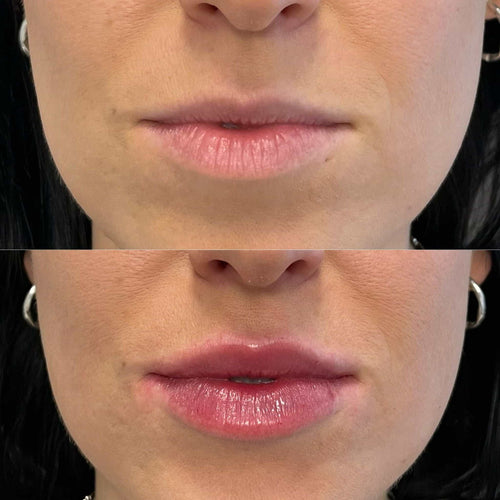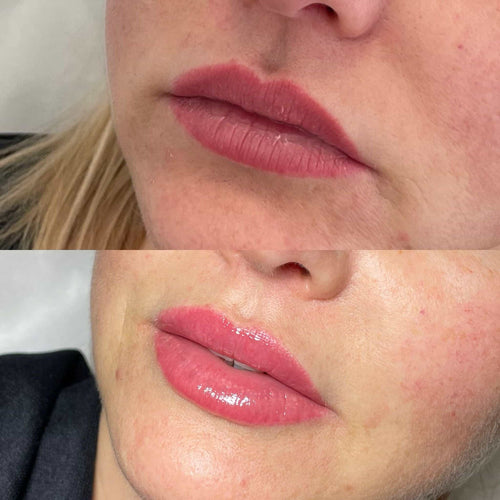Reserve a Dermal Filler Consultation with Dr. Laura Geige
Factors Affecting Filler Longevity
Smoking Habits
Dermal fillers are a popular cosmetic treatment used to enhance facial features, reduce wrinkles and restore volume. However, one factor that significantly impacts filler longevity is smoking habits.
Nicotine, found in cigarette smoke, constricts blood vessels. This reduced blood flow limits the delivery of nutrients and oxygen to the injected filler, hindering its integration into the surrounding tissue and potentially leading to faster breakdown.
Furthermore, smokers generally have less collagen production due to the damaging effects of nicotine on fibroblasts, the cells responsible for collagen synthesis. Collagen is a crucial structural protein that provides support and elasticity to the skin. Reduced collagen levels can accelerate filler degradation.
Additionally, smoking promotes inflammation and free radical damage in the body. These factors can further contribute to the breakdown of filler material, shortening its lifespan.

Studies have shown that smokers may experience a **50% reduction** in the longevity of dermal fillers compared to non-smokers.
Therefore, if you’re considering dermal fillers, it is essential to discuss your smoking habits with your practitioner. They can advise on realistic expectations and potential strategies to maximize filler longevity, such as quitting smoking before and after treatment.
Skin Type and Elasticity
Numerous factors influence the longevity of dermal filler treatments, including smoker’s lines. Understanding these factors can help patients make informed decisions about their treatment and expectations.
Schedule Your Dermal Filler Appointment at It’s Me and You Clinic with Dr. Laura Geige
One crucial factor is the type of filler used. Hyaluronic acid (HA) fillers, such as Juvederm and Restylane, are popular choices for treating smoker’s lines. These fillers are temporary, typically lasting between six months to a year or longer depending on the specific product and individual factors.
Skin type plays a significant role in filler longevity. Individuals with thinner, more delicate skin may experience faster filler degradation compared to those with thicker, more resilient skin.
Elasticity is another key factor. Skin with lower elasticity tends to metabolize fillers more quickly. Smokers, due to the damaging effects of nicotine on collagen and elastin fibers, often have reduced skin elasticity, potentially leading to shorter filler duration.
Lifestyle habits also influence filler longevity. Smoking accelerates collagen breakdown and impairs blood circulation, which can shorten the lifespan of fillers.
Sun exposure can also degrade fillers. UV rays damage collagen and elastin, compromising the skin’s structure and affecting filler integration.
Facial expressions and muscle movement can contribute to filler dispersion and degradation. Frequent frowning or smiling in the treated area may lead to faster breakdown of the filler.
The injector’s experience and technique also play a role. Precise placement and proper volume distribution can help maximize filler longevity.
In summary, various factors contribute to the duration of dermal fillers, particularly in treating smoker’s lines. Skin type, elasticity, smoking habits, sun exposure, facial expressions, and injector skill all influence how long the results last.
Treatment Location and Technique
Smoker’s lines, also known as *perioral rhytides*, are fine wrinkles that form around the mouth due to repeated muscle contractions from smoking.
Dermal fillers can effectively reduce their appearance. However, understanding factors affecting filler longevity is crucial for patients seeking long-lasting results in this area.
Here’s a breakdown of key considerations:
- Filler Type:
- Treatment Location:
- Smoking Habits:
- Sun Exposure:
- Age:
- Skin Health:
- Treatment Technique:
Different dermal fillers have varying durations. Hyaluronic acid (HA) fillers, like Restylane and Juvederm, are popular choices for smoker’s lines. Their longevity generally ranges from 6 to 18 months, depending on the specific product and individual factors.
The location of treatment can influence filler longevity. Areas with higher muscle activity, like around the mouth, tend to break down fillers faster compared to areas with less movement.
Smoking is a major factor affecting filler longevity in *perioral rhytides*. Nicotine constricts blood vessels, hindering blood flow to the treatment area. This can lead to reduced filler absorption and accelerated breakdown.
Ultraviolet (UV) radiation from the sun can also degrade fillers over time. Sun protection is crucial for preserving filler results.
Collagen production naturally declines with age, making it more challenging for fillers to integrate and last as long in older individuals.
Individuals with compromised skin health due to conditions like eczema or rosacea may experience shorter filler longevity.
The skill and experience of the injector play a role. Proper placement, product selection, and injection technique can optimize filler integration and longevity.
It’s important to consult with a qualified and experienced aesthetic practitioner to determine the most suitable filler type, treatment plan, and realistic expectations for longevity in your specific case.
Expected Lifespan of Fillers in Smoker’s Lines
Average Duration
Fillers can temporarily smooth out smoker’s lines, which are wrinkles and creases caused by repeated muscle contractions from smoking.
However, the lifespan of these fillers in smoker’s lines is generally shorter compared to other areas of the face due to several factors:
-
Increased Collagen Breakdown: Smoking damages collagen, a protein essential for skin elasticity and structure. This accelerated breakdown can cause fillers to degrade faster.
-
Poor Blood Circulation: Nicotine constricts blood vessels, reducing blood flow to the injection site. This impairs nutrient supply and waste removal, potentially affecting filler longevity.
-
Inflammation: Smoking triggers chronic inflammation, which can interfere with the integration of fillers into the skin and accelerate their breakdown.
On average, fillers for smoker’s lines typically last 6 to 12 months.
Factors influencing longevity include:
-
Type of filler used: Hyaluronic acid fillers generally have shorter lifespans (6-9 months) than other types like poly-L-lactic acid.
-
Depth and extent of wrinkles
-
Individual metabolism and skin health
-
Smoking habits: Heavier smokers may experience faster filler degradation.
It’s crucial for smokers considering fillers to understand that their results may not be as long-lasting as for non-smokers.
Quitting smoking can significantly improve skin health and potentially prolong the effects of fillers.
Individual Variation
Smokers’ lines are caused by years of repeated muscle contractions from smoking, leading to wrinkles around the mouth and lips. These lines tend to be deeper and more resistant to treatment compared to other types of wrinkles.
Dermal fillers can help smooth out these lines, but their longevity in smokers’ lines is often shorter than in non-smokers due to several factors:
- Increased Collagen Breakdown: Smoking significantly accelerates collagen and elastin degradation. These proteins are crucial for skin structure and elasticity. Faster breakdown means fillers may be broken down quicker.
- Compromised Blood Flow: Nicotine constricts blood vessels, hindering the circulation of nutrients and oxygen to the skin. This can affect how well the body integrates and supports fillers.
- Inflammation: Smoking promotes chronic inflammation in the body, including the skin. This can interfere with healing processes and potentially lead to filler degradation.
On average, fillers injected into smokers’ lines might last anywhere from 6 to 12 months. However, individual results can vary greatly.
Factors influencing filler longevity in smokers include:
- Type of Filler Used: Some fillers are designed to last longer than others. Hyaluronic acid (HA) fillers, for example, generally last less than volumizing fillers containing poly-L-lactic acid.
- Depth and Volume of Injection: Deeper injections and larger volumes may last longer.
- Individual Skin Health and Metabolism: Some people naturally metabolize substances faster, leading to shorter filler duration.
It’s important for individuals considering fillers to discuss their smoking habits with a qualified practitioner. They can assess the individual’s skin condition, expectations, and potential risks to determine the most suitable treatment plan.
Maintaining Results and Extending Filler Lifespan
Lifestyle Modifications
Book a Dermal Filler Session with Dr. Laura Geige Now

Maintaining results and extending filler lifespan requires a multifaceted approach that considers both lifestyle factors and proper aftercare.
Lifestyle Modifications:
- Sun Exposure: UV radiation degrades hyaluronic acid, the most common filler ingredient. Protect treated areas with sunscreen (SPF 30 or higher) daily, even on cloudy days. Wear wide-brimmed hats and protective clothing for added shielding.
- Smoking: Smoking significantly reduces blood flow to the skin, hindering collagen production and affecting filler longevity. Quitting smoking is crucial for maximizing results and promoting overall skin health.
- Alcohol Consumption: Excessive alcohol intake can dehydrate the skin, leading to faster breakdown of fillers. Moderation is key to maintaining hydration and optimal filler performance.
- Diet: A healthy diet rich in antioxidants, vitamins, and minerals supports collagen synthesis and overall skin health. Focus on consuming fruits, vegetables, lean protein, and healthy fats.
Aftercare Instructions:
- Avoid Touching or Massaging: Resist the urge to touch or massage the treated areas for at least 24 hours post-injection. This minimizes the risk of bruising, swelling, and filler displacement.
- Ice Packs: Apply ice packs wrapped in a towel to reduce initial swelling and discomfort.
- Elevated Head Position: Sleeping with your head elevated can minimize facial puffiness.
- Hydration: Drink plenty of water to keep the skin hydrated, which aids in filler absorption and longevity.
Regular Follow-up Appointments:
It’s essential to schedule follow-up appointments with your injector as recommended. This allows them to assess filler placement, address any concerns, and potentially top up the product for sustained results.
Follow-Up Treatments
Maintaining the results of dermal filler injections, especially in the area known as smoker’s lines, requires a combination of post-treatment care and strategic follow-up treatments.
Smoker’s lines are dynamic wrinkles that form around the mouth due to repetitive muscle movements, particularly those associated with smoking. These lines tend to be more pronounced and resistant to traditional dermal filler solutions compared to static wrinkles.
Here are some key factors influencing filler lifespan in smoker’s lines and strategies for extending their effects:
-
Filler Type:
Different dermal fillers have varying compositions and durations of effect. Hyaluronic acid-based fillers tend to be more temporary, lasting 6 to 18 months, while some newer longer-lasting options can provide results for up to 2 years or more.
-
Treatment Area:
Filler longevity in smoker’s lines may be shorter than in other areas due to increased muscle activity and movement.
-
Lifestyle Factors:
Smoking, excessive sun exposure, alcohol consumption, and dehydration can all contribute to faster filler breakdown. These habits should be minimized for optimal results.
Follow-up treatments are essential to maintain the desired effects of dermal fillers in smoker’s lines.
A typical recommendation is a follow-up appointment 6 months after the initial treatment, followed by touch-up appointments as needed based on individual results and skin characteristics.
During these follow-up sessions, your provider will assess the filler volume, adjust placement if necessary, and inject additional product to restore fullness and smooth wrinkles.
By diligently following your provider’s recommendations for post-treatment care and scheduling regular follow-up appointments, you can significantly extend the lifespan of dermal fillers in smoker’s lines and maintain a youthful appearance.
A Glossy Life Blog Fringe Beverly Hills Press on Honey Cleveland Relationship Therapy
- What Happens When You Are Ghosted? The Psychological Impact - June 1, 2025
- Nasolabial Fold Fillers – Marionette Lines Near Thames Ditton, Surrey - May 31, 2025
- The Dark Side Of Ghosting And Its Effect On Trust In Dating - May 30, 2025
